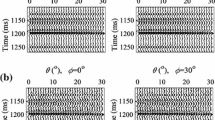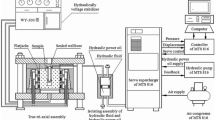Abstract
Fracture identification is important for the evaluation of carbonate reservoirs. However, conventional logging equipment has small depth of investigation and cannot detect rock fractures more than three meters away from the borehole. Remote acoustic logging uses phase-controlled array-transmitting and long sound probes that increase the depth of investigation. The interpretation of logging data with respect to fractures is typically guided by practical experience rather than theory and is often ambiguous. We use remote acoustic reflection logging data and high-order finite-difference approximations in the forward modeling and prestack reverse-time migration to image fractures. First, we perform forward modeling of the fracture responses as a function of the fracture–borehole wall distance, aperture, and dip angle. Second, we extract the energy intensity within the imaging area to determine whether the fracture can be identified as the formation velocity is varied. Finally, we evaluate the effect of the fracture–borehole distance, fracture aperture, and dip angle on fracture identification.
Similar content being viewed by others
References
Baysal, E., Dan, D. K., and Sherwood, J. W. C., 1983, Reverse time migration: Geophysics, 48(11), 1514–1524.
Baysal, E., Kosloff, D. D., and Sherwood, J. W. C., 1994, A two-way nonreflecting wave equation: Geophysics, 49(2), 132–141.
Berenger, J., P., 1994, A perfectly matched layer for the absorption of electromagnetic waves: Journal of Computational Physics, 114(2), 185–200.
Chabot, L., Henley, D. C., and Brown, R. J., et al., 2001, Single-well imaging using the full waveform of an acoustic sonic: 71th Annual International Meeting, SEG, Expanded Abstracts, 20(1), 420–423.
Chabot, L., Henley, D. C., and Brown, R. J., et al., 2002, Single-well seismic imaging using full waveform sonic data, An update: 72th Annual International Meeting, SEG, Expanded Abstracts, 21(1), 368–371.
Chai, X. Y., Zhang, W. R., and Wang, G. Q., et al., 2009, Application of remote exploration acoustic reflection imaging logging technique in fractured reservoir: Well Logging Technology (in Chinese), 33(6), 539–543.
Chang, W. F., and Mcmechan, G. A., 1986, Reverse time migration of offset vertical seismic profiling data using the excitation time imaging condition: Geophysics, 51(1), 67–84.
Chang, W. F., and Mcmechan, G. A., 1987, Elastic reverse time migration: Geophysics, 52(10), 1365–1375.
Chang, W. F., and Mcmechan, G. A., 1990, 3-D acoustic prestack reverse time migration: Geophysical Prospecting, 38(7), 737–755.
Chang, W. F., and Mcmechan, G. A., 1994, 3-D elastic prestack reverse time depth migration: Geophysics, 1994, 59(4), 597–609.
Chattopadhyay, S., and Mcmechan, G. A., 2008, Imaging conditions for prestack reverse time migration: Geophysics, 73(3), S81–S89.
Che, X. H., and Qiao, W. X., 2003, The equivalent phased receiver array and its application in processing of acoustic logging waveforms: Well Logging Technology (in Chinese), 27(1), 23–26.
Gong, H., He, X., Chen, H., and Wang, X. M., 2015, Eliminating the azimuth ambiguity in single-well imaging using 3C sonic data: Geophysics, 80(1), A13–A17.
Guo, S. J., Li, Z. C., Sun, X. D., et al., 2008, Post-stack reverse time migration using a finite difference method based on triangular grids: Applied Geophysics, 5(2), 115–120.
Guo, Z. B., and Li, Z. C., 2014, True-amplitude imaging based on least-squares reverse time migration: Oil Geophysical Prospecting (in Chinese), 49(1), 120.
He, F. J., 2005, The study on the simulation of the borehole acoustic reflection imaging logging tool and it’s waveform processing method: PhD thesis, China University of Petroleum.
Hemon, C., 1978, Equations d’onde et modeles: Geophysical Prospecting, 26(4), 790–821.
Hornby, B. E., 1989, Imaging of near-borehole structure using full-waveform sonic data: Geophysics, 54(6), 747–757.
Kang, W., and Cheng, J. B., 2012, Pseudo-acoustic wave equations for reverse-time migration in TImedia: Chinese Journal Geophysics, 55(3), 1033–1045.
Li, C., Yue, W., He, Y., and Guo, R., 2014, Elastic wave reverse time migration for directional dipole reflection imaging: 82th Annual International Meeting, SEG Expanded Abstracts 2014, 638–642.
Li, C., Yue, W. Z., and Jin, H. L., et al., 2013, Progresses of data processing methods for acoustic reflection imaging logging: Well Logging Technology (in Chinese), 37(1), 13–20.
Li, N., Xiao, C. W., and Wu, L. H., et al., 2014, The innovation and development of log evaluation for complex carbonate reservoir in china: Well Logging Technology (in Chinese), 38(01), 1–10.
Levin, S. A., 1984, Principles of reverse time migration: Geophysics, 49(5), 581–583.
Levy, B. C., and Esmersoy, C., 1986, Variable background born inversion by wave field back propagation: Journal on Applied Mathematics, 48(4), 952–972.
Kaelin, B., and Guitton, A., 2006, Imaging condition for reverse time migration: 76th Annual International Meeting, SEG, Expanded Abstracts, 25(1), 2594–2598.
Mulder, W. A., and Plessix, R., 2003, One-way and twoway wave equation migration: 73th Annual International Meeting, SEG Expanded Abstracts 69(6), 2452.
Sun, R., and McMechan, G. A., 1986, Prestack reverse time migration for elastic waves with application to synthetic offset vertical seismic profiles: Proceedings of the IEEE, 74(3, 457–465.
Sun, R., and Wang, A., 2001, Scalar reverse time depth migration of elastic seismic data: Geophysics, 66(5), 1519–1527.
Su, Y. D., Wei, Z. T., and Tang, X. M., 2014, Validation method of dipole acoustic reflection imaging from the adjacent borehole reflection: Applied Acoustics, 33(1), 29–34.
Tang, X. M., and Patterson, D., 2009, Shear-wave imaging using cross-dipole acoustic logging tool: 79th Annual International Meeting, SEG Expanded Abstracts, 28(1), 421–425.
Tang, X. M., Wei, Z., Su, Y. D., et al., 2013, A Review on the progress and application of dipole acoustic reflection imaging technology: Well Logging Technology (in Chinese), 37(4), 333–340.
Tang, X. M., Zheng, Y., and Patterson, D., 2006, Processing acoustic logging data to image near-borehole geological structures: 76th Annual International Meeting, SEG, Expanded Abstracts, 25(1), 339–343.
Wang, G. Q., Liu, J. D., and Wen, D. J., et al., 2014, Carbonate reservoir productivity forecasting technology based on distance detection acoustic logging tool: Well Logging Technology (in Chinese), 38(6),745–748.
Wang, N. X., Su, H., and Liu, W. M., et al., 1998, Analysis of reflection image in sonic full waveform logging: Well Logging Technology (in Chinese), 25(1), 339–343.
Wang, S. D., 2003, Absorbing boundary condition for acoustic wave equation by perfectly matched layer: Oil Geophysical Prospecting (in Chinese), 38(1), 31–34.
Wei, Z. T., Tang, X. M., and Su, Y. D., et al., 2013, A new acoustic remote sensing method utilizing borehole lowfrequency dipole shear wave: Geophysics (in Chinese), 56(10), 3572–3580.
Wei, Z. T., Tang, X. M., and Zhuang, C. X., 2013, Fardetecting logging by oriented dipole P-wave in an acoustically slow formation. Acta Petrolei Sinica (in Chinese), 34(5), 905–913.
Whitmore, N. D., 1983, Iterative depth imaging by backward time propagation: 58th Annual International Meeting, SEG, Expanded Abstracts, 2(5), 646.
Xiao, C. W., Li, J. X., and Wu, X. N., et al., 2014, Splitstep Fourier migration in remote exploration acoustic reflection imaging logging: Well Logging Technology (in Chinese), 38(2), 174–138.
Yoon, K., Marfurt, K. J., Houston, U., et al., 2004, Challenges in reverse time migration: 74th Annual International Meeting, SEG, Expanded Abstracts, 1057–1060.
Zhuang, C. X., Yan, F., and Sun, Z. F., et al., 2014, Data processing and applications of dipole shear-wave imaging logging: Well Logging Technology (in Chinese), 38(3), 330–336.
Zhang, C. Y., Li, Z. C., and Sun, X. D., 2010, Review on the technology of reverse time migration: Progress of Exploration Geophysics, (05), 309–317.
Zhu, J., and Lines, L., 1994, Imaging of complex subsurface structures by VSP migration: Canadian Journal of Exploration Geophysics, 30(1), 73–83.
Author information
Authors and Affiliations
Corresponding author
Additional information
The Study work is supported by National Petroleum Major Project (Grant No. 2011ZX05020-008).
Zhang Gong, received his M.Eng. in 2013 from Yangtze University. He is currently a Ph.D. student at Peking University and the Research Institute of Petroleum Exploration and Development (RIPED), CNPC. His main research interests are well logging data processing and software development.
Rights and permissions
About this article
Cite this article
Zhang, G., Li, N., Guo, HW. et al. Fracture identification based on remote detection acoustic reflection logging. Appl. Geophys. 12, 473–481 (2015). https://doi.org/10.1007/s11770-015-0522-0
Received:
Revised:
Published:
Issue Date:
DOI: https://doi.org/10.1007/s11770-015-0522-0




